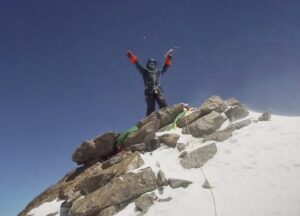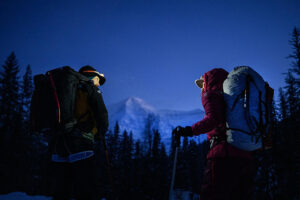It turns out that the claimed first Nepali ascent of Chhopa Bamare was not a first ascent. It even seems that the Dolma Outdoor and Himalayan Shepherd teams never reached that summit at all.

A member of the Bidu Municipality team holds a Nepal flag on what Himalayan Shepperd insists is the summit of Chhopa Bamare. Photo: Himalayan Shepherd
Ten days ago we published an announcement from Nepali outfitters about an ascent of 6,109m Chhopa Bamare in Rolwaling. We mentioned in the story that John Kelley of the U.S. and Benjamin Billet of France first climbed the peak in February 2019 via the southeast ridge. This difficult ascent gained them international attention and they were shortlisted for the Piolet d’Or that year, Billet told ExplorersWeb.
The Himalayan Database duly accepted their climb.
Recently, two related Nepali outfitters, Himalayan Shepherd and Dolma Outdoor, (managed by brothers Nima Gyalzen and Pemba Dorje Sherpa, respectively), claimed the first “official” ascent, in a written reply to questions from ExplorersWeb.
Unreliable data
They noted that the peak still was tagged as unclimbed on the Nepal Himal Peak Profile website, managed by Nepali tourism officials. (Note: Nepal Himal Peak Profile contains a lot of outdated data and wrong peak altitude. For that reason, climbers rarely used it as a reference.)
Newspapers in Nepal headlined the climb as a first Nepali ascent for the team led by Dolma Outdoor’s Nima Gyalzen, his brother Phurba Thiley Sherpa, and the chairperson of Bigu municipality Sanjeeb Oli. Lila Bahadur Basnet, Lakpa Gelji Sherpa, and Bhabindra Khadka also took part in the climb.
They reportedly summited on Dec. 29, 2023. All posed with a big banner that proclaimed the achievement as “first ascent.” See the photo below and the claims published by The Himalayan Times.

Nepali climbers with a banner showing their portraits under a “first ascent” claim. Nima Gyalzen is at right. Photo: The Himalayan Times/Himalayan Shepherd
Unfair accusations
At the time, John Kelley was climbing in western Nepal. When he reached an area with wifi, he found out about the news. Worse, he and Billet faced accusations within the country that they might have done their climb without a permit.
“That is simply not the case,” a shocked Kelley told ExplorersWeb from Makarigod village. “It was 100% an authorized, official, and legal ascent for which we paid $3,000.”
The climbers provided proof, including the photo below showing them with the permit in the company of Nepal’s then-director of Tourism. Screenshots from Nepal’s Government Facts & Figures book note that the U.S.-French team successfully summited the peak. This list is available at the website of Nepal’s Ministry of Culture, Tourism, and Civil Aviation.

The climbers with Nepal’s then-Director of Tourism, plus representatives from their local outfitter for Chhopa Bamare. Photo: Benjamin Billet

Screenshot showing the permit granted to Kelley and Billet in 2019, as filed by Nepal’s Ministry of Culture, Tourism, and Civil Aviation.
The climbers obtained a 45-day permit in February 2019. It was filed as a spring permit since it was valid beyond the official winter season, which ends on February 28.

The climbing permit issued for Kelley and Billet to climb Chhopa Bamare. Photo: Benjamin Billet
“If the Nepalis claim theirs was a first ascent, it seems clear that they have not done any previous research,” said Benjamin Billet.
Kelley and Billet were also flabbergasted when they saw Himalayan Shepherd’s summit photos and videos.
Not a summit at all?
“I do not recognize that place, but it is not the summit of Chhopa Bamare,” Billet said after watching the summit video.
“This photo is absolutely not the summit of Chhopa Bamare,” Kelley agreed.
Here’s the summit picture they are referring to:

Nima Gyalzen on the supposed summit of Chhopa Bamare. Photo: Himalayan Shepherd/Dolma Outdoor
And here’s the one by the 2019 climbers:

Billet (left) and Kelley on the spiky, rocky summit of Chhopa Bamare. “The summit is directly in front of us,” Kelley told ExplorersWeb. “It’s rock.”
The summit of Chhopa Bamare, Billet and Kelley explained, is a rocky point. “We climbed in the very snowy year of 2019, and the summit was still bare rock,” Kelly explained. “This winter I have been in Nepal and there’s not been a single snowfall, so there is no way that the summit might be on snow, as shown in the pictures.”

John Kelley right before the summit of Chhopa Bamare. Photo: Benjamin Billet
“There was another high point, directly at the top of the south face, that is ice covered. It’s steep and pointed,” Kelley recalled. “We weren’t sure which was higher. We visited both to be sure, even though the GPS coordinates said the summit was the rocky one.”

Chhopa Bamare with its characteristic rocky, pointy summit. Photo: Benjamin Billet
The view from the summit
As for geographical references, Chhopa Bamare faces Gaurishankar, a monster peak of 7,134m with an unmistakable shape. The Nepali outfitters that featured a video of a flattish summit said that you could see Everest, Lhotse, and Cho Oyu from up there. Billet said he was not sure whether Everest was visible from the summit, but Gaurishankar stood out amid a sea of peaks. On the other side of the summit lay Tibet.

Gaurishankar stands out among other peaks from Kelley and Billet’s high camp. Photo: Benjamin Billet
Below is the summit video provided by Himalayan Shepherd.
Asked by ExplorersWeb, Himalayan Shepherd insisted that the images and videos were from the summit. They climbed with clients and fixed ropes at some points.
Kelley and Billet offered a third point of controversy: There is no easy way up the peak that they know of.
“I heard the east face might be easier but I have not been there,” said Billet. The Nepalis said that they climbed the south side of the mountain. Kelley and Billet went alpine style up the southeast face and the southwest ridge on a four-day climb. Here is their route topo:

Line (in green) of the route followed by Kelley and Billet in 2019 on Chhopa Bamare. Photo: Benjamin Billet
For more info, here is a short film on the expedition:
Himalayan Shepherd’s take
We contacted a spokesperson at Himalayan Shepherd but obtained no satisfactory explanation, although they admitted that they weren’t sure if they were the first summiters.
They also remarked that they only wanted to open another peak to potential clients. “We and the local government just wanted to climb a good route and promote the mountain…We would never do anything wrong.”
In the end, theirs wasn’t a first ascent and it remains unclear whether it was an ascent at all. We have asked the Nepalis for a detailed report and any official certification they may have obtained.
A history of controversy
“I will go to the Ministry of Tourism in a few days for an expedition debriefing of the peak I just failed to climb and I will absolutely bring this to their attention,” Kelley said. “Nima Gyalzen is a flat-out liar.”
Unfortunately, Nepali tourism authorities seem to lack reliable sources of information and tools to keep track of ascents.
It is not the first time Nima Gyalzen or Pemba Dorje have been involved in summit controversies. Nima Gyalzen led the expeditions of Taiwan’s Grace Tseng as she pursued the 14×8,000’ers. He was with her on Kangchenjunga, where it was later proven that the team had not reached the main summit. He and Tseng also did a very controversial ascent of Manaslu, after every other expedition had abandoned the mountain because of high avalanche danger.
The team’s claim that Grace Tseng climbed without supplementary O2 in only 13 hours was disputed by many climbers and mountain media. This year, when other climbers attempted an FKT (fastest known time) on Manaslu, they targeted the previous score set by Francois Cazzanelli. They ignored Tseng and Nima Gyalzen’s claims.
Pemba Dorje claimed a speed record on Everest in 2004, which was later rejected by Nepal’s Supreme Court, the Ministry of Culture, Tourism and Civil Aviation, and the Guinness World Records.
Meanwhile, Chhopa Bamare is still listed as unclimbed on the Nepal Himal Peak Profile website.






